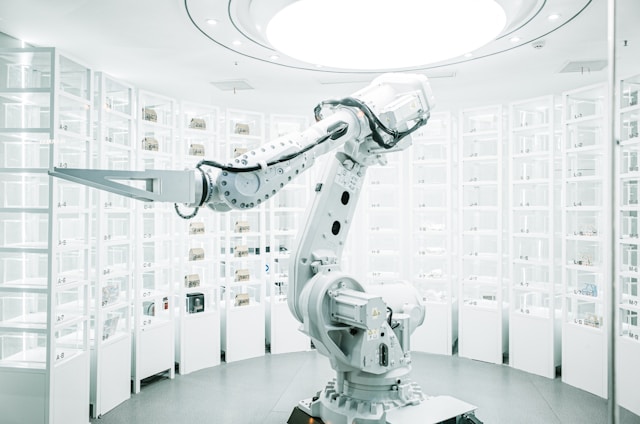AI and Robotics Transform the Traditional Pharmacy Model

The neighborhood pharmacy is getting a high-tech makeover. From artificial intelligence-powered inventory management to robotic prescription filling, emerging technologies are revolutionizing how pharmacies operate. Industry leaders say these changes aren’t just about efficiency – they’re about survival.
“The pharmacies that thrive in the next decade will be the ones embracing technology today,” says Dr. Rebecca Chang, Director of Innovation at HealthTech Pharmaceuticals. “We’re seeing a complete transformation of the business model, driven by B2B technologies that are more accessible and affordable than ever before.” One such example is Canadian Pharmacy B2B, which provides a platform for pharmacies to streamline their procurement processes, ensuring they can source medications and supplies efficiently from trusted suppliers.
Automation Takes Center Stage
At Pioneer Pharmacy in Seattle, a robotic prescription filling system now handles over 80% of routine medications. “Our pharmacists used to spend 70% of their time counting pills,” says owner James Martinez. “Now they’re spending that time consulting with patients and managing complex care plans.”
The results have been dramatic. Prescription errors have dropped by 99%, while patient consultation time has tripled. The initial investment – roughly $200,000 – paid for itself within 18 months.
AI Drives Inventory Innovation
Artificial intelligence is making waves in inventory management. SmartRx, a startup specializing in pharmacy AI, has developed a system that predicts inventory needs with remarkable accuracy.
“Our AI analyzes everything from local health trends to weather patterns,” explains SmartRx CEO Sarah Johnson. “When flu season hits, the system automatically adjusts ordering patterns. When a new housing development breaks ground nearby, it factors in population growth.”
Blockchain Ensures Supply Chain Integrity
Concerns about counterfeit medications have spurred adoption of blockchain technology. A consortium of independent pharmacies recently launched a blockchain-based verification system that tracks medications from manufacturer to patient.
“We can now trace any medication’s complete journey in seconds,” says Tom Chen, PharmD, who participated in the pilot program. “If there’s a recall, we can immediately identify and notify affected patients. The impact on patient safety is enormous.”
Virtual Reality Transforms Training
Virtual reality is revolutionizing staff training. National Pharmacy Chain (NPC) has implemented VR training modules that simulate everything from customer interactions to emergency situations.
“We’ve cut training time by 40% while improving retention rates,” reports Maria Rodriguez, NPC’s Director of Training. “New staff members can practice handling difficult situations without risk, and experienced pharmacists can maintain their skills.”
Real-Time Analytics Drive Decision Making
Modern pharmacies are becoming data powerhouses. Cloud-based analytics platforms are providing insights that were previously impossible to obtain.
“We can see patterns we never noticed before,” says David Park, owner of three independent pharmacies in Chicago. “We know exactly when to staff up, which services are most profitable, and how to optimize our product mix. It’s like having a business consultant working 24/7.”
The Internet of Things Monitors Everything
IoT sensors are transforming medication storage and handling. Smart refrigerators maintain precise temperatures for sensitive medications, automatically documenting any fluctuations and alerting staff to potential problems.
“Last month, our system detected a failing refrigeration unit at 2 AM,” shares Lisa Wong, operations manager at MedPlus Pharmacy. “It automatically moved to backup power and notified our maintenance team. Without this technology, we could have lost $100,000 in specialty medications.”
Challenges and Opportunities
The transition to high-tech pharmacy operations isn’t without challenges. “The biggest hurdle is integration,” notes Dr. Chang. “Many pharmacies are running multiple systems that don’t talk to each other. Getting everything working together seamlessly takes time and expertise.”
Cost remains another significant factor. While prices for many technologies are falling, the initial investment can be substantial. However, financing options are expanding.
“We’re seeing more flexible payment models,” says Michael Brown, healthcare technology consultant. “Vendors are offering subscription-based services instead of large upfront purchases. This makes advanced technology accessible to smaller pharmacies.”
The Human Element Remains Critical
Despite the tech transformation, industry experts emphasize that technology should enhance, not replace, human interaction.
“The goal is to automate routine tasks so our pharmacy team can focus on what matters most – patient care,” explains Dr. Emily Stewart, clinical pharmacy director at Urban Health Network. “Technology handles the repetitive work, freeing our pharmacists to provide the personal attention and clinical expertise that no machine can replicate.”
Looking Ahead
The pace of technological change shows no signs of slowing. Emerging technologies like quantum computing and advanced robotics promise even more dramatic changes in the years ahead.
“We’re just seeing the beginning,” predicts Johnson. “The pharmacy of 2030 will be as different from today as today’s pharmacy is from the apothecaries of the past.”
For pharmacy owners like Martinez, the message is clear: “Adapt or risk becoming obsolete. These aren’t just cool new toys – they’re essential tools for survival in modern healthcare.”
The transformation of pharmacy operations continues, driven by technologies that promise greater efficiency, accuracy, and patient care. For those willing to embrace change, the future of pharmacy looks bright indeed.
John Davis is a seasoned health journalist with expertise in public health and medical research. Holding a degree in health sciences, John excels in making complex health topics understandable and engaging for his readers. His articles, featured in top health publications, cover everything from cutting-edge treatments to public health policies. Outside of journalism, John is an advocate for health education and frequently speaks at community events.





